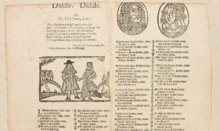Lavender's Blue
| Lavender's Blue | |
|---|---|
| English folk song | |
 A 17th-century broadside version of the ballad | |
| Catalogue | Roud 3483 |
| Genre | Nursery rhyme |
| Published | English broadside (before 1680) |
| Comment | collected in the UK & US |
| Comment | collected in the UK & US |
"Lavender's Blue" (sometimes called "Lavender Blue") is an English folk song and nursery rhyme dating to the 17th century. It has a Roud Folk Song Index number of 3483. It has been recorded in various forms since the 20th century and some pop versions have been hits in the US and UK charts.
Lyrics[]
There are as many as thirty verses to the song, and many variations of each verse. A typical version, described by James Halliwell in 1849,[1] is:
- Lavender's blue, dilly dilly, lavender's green,
- When I am king, dilly dilly, you shall be queen:
- Who told you so, dilly dilly, who told you so?
- 'Twas mine own heart, dilly dilly, that told me so.
- Call up your men, dilly dilly, set them to work,
- Some with a rake, dilly dilly, some with a fork;
- Some to make hay, dilly dilly, some to thresh corn,
- Whilst you and I, dilly dilly, keep ourselves warm.
- If you should die, dilly dilly, as it may hap,
- You shall be buried, dilly dilly, under the tap;
- Who told you so, dilly dilly, pray tell me why?
- That you might drink, dilly dilly, when you are dry.[1]
Origins[]
| Wikisource has original text related to this article: |
The earliest surviving version of the song is in a broadside printed in England between 1672 and 1679,[2] under the name Diddle Diddle, Or The Kind Country Lovers.[3] The broadside indicates it is to be sung to the tune of "Lavender Green", implying that a tune by that name was already in existence. The lyrics printed in the broadside are fairly bawdy, celebrating sex and drinking.[4]
According to Robert B. Waltz, "The singer tells his lady that she must love him because he loves her. He tells of a vale where young man and maid have lain together, and suggests that they might do the same". Waltz cites Sandra Stahl Dolby as describing this broadside version as being about a girl named Nell keeping the singer's bed warm.[2]
Here is the first of ten verses:
Lavender's green, diddle, diddle,
Lavender's blue
You must love me, diddle, diddle,
cause I love you,
I heard one say, diddle, diddle,
since I came hither,
That you and I, diddle, diddle,
must lie together.[5]
Both Waltz (citing Eloise Hubbard Linscott) and Halliwell have noted the song's association with Twelfth Night and the choosing of the king and queen of the festivities of that holiday.[2][1]

"Lavender's Blue" emerged as a children's song in Songs for the Nursery in 1805 in the form:
Lavender blue and Rosemary green,
When I am king you shall be queen;
Call up my maids at four o'clock,
Some to the wheel and some to the rock;
Some to make hay and some to shear corn,
And you and I will keep the bed warm.[5]
Similar versions appeared in collections of rhymes throughout the 19th century.[5]
Recordings[]
Several versions of the song have been released in the US, the UK, and Australia.[2] Some of the more notable include:
- Burl Ives' hit version, titled "Lavender Blue", which was featured in the Walt Disney film So Dear to My Heart and was nominated for the Academy Award for Best Original Song.[6]
- Sammy Kaye's 1949 version, charting at #5;[7]
- Dinah Shore's on her 1949 album Lavender Blue that went to #1 on the Australian chart;[8]
- Sammy Turner's in 1959 that reached #3 on the Billboard Hot 100.[9][10]
- In 1976, the early music group The City Waites recorded the original 17th-century bawdy broadside version of "Lavender's Green, Lavender's Blue" on their album Pills to Purge Melancholy.[11]
- On their 1985 album Misplaced Childhood, the British rock band Marillion recorded a song called "Lavender", which quoted lines derived from the folk song and became a number 5 hit on the UK Singles Chart.[12][13][14]
References[]
- ^ Jump up to: a b c Halliwell, James Orchard (1849). Popular Rhymes and Nursery Tales. London: John Russell Smith. pp. 237–238. ISBN 978-0370012551. Retrieved March 7, 2017.
- ^ Jump up to: a b c d Robert B. Waltz & David G. Engle. "Lavender Blue". Traditional Ballad Index. California State University, Fresno. Retrieved March 7, 2017.
- ^ See also here
- ^ (Traditional) (1674–1679). "Diddle, Diddle (or The Kind Country Lovers)". Traditional Music Library. Retrieved March 7, 2017.
- ^ Jump up to: a b c Opie, Iona; Opie, Peter (1951). The Oxford Dictionary of Nursery Rhymes. Oxford University Press. pp. 265–7. ISBN 9780198691112.
- ^ James Robert Parish, Michael R. Pitts, Hollywood Songsters: Garland to O'Connor, Taylor & Francis, 2003, p.404
- ^ "Billboard Best Sellers Chart History – "Lavender Blue (Dilly Dilly)" by Sammy Kaye 1949". Song Database. Retrieved March 7, 2017.
- ^ "Song artist 62 - Dinah Shore". The World's Music Charts. Retrieved March 7, 2017.
- ^ "Billboard Hot 100 Chart History – "Lavender-Blue" by Sammy Turner 1959". Song Database. Retrieved March 7, 2017.
- ^ "Sammy Turner Top Songs". Music VF. Retrieved March 7, 2017.
- ^ Discogs
- ^ "Lavender, Marillion Lyrics.com
- ^ Simply Eighties
- ^ "Marillion". Official Charts. Retrieved 11 April 2021.
External links[]
 Media related to Lavender's Blue at Wikimedia Commons
Media related to Lavender's Blue at Wikimedia Commons
- 17th-century songs
- English folk songs
- English nursery rhymes
- Number-one singles in Australia
- Year of song unknown
- Songwriter unknown
- English children's songs
- Traditional children's songs